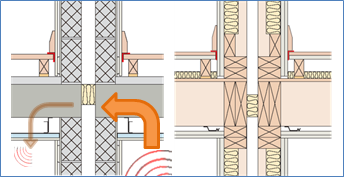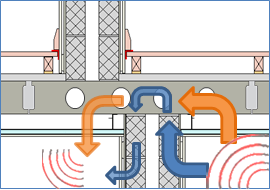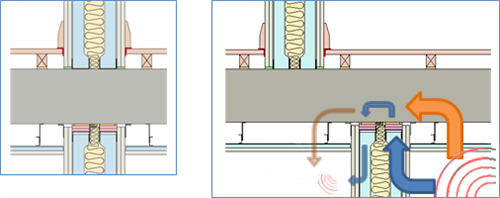Staggering performance

Separating wall to separating floor’ junctions in the Handbook are always shown with the wall above the floor directly aligned with the one below.
This arrangement allows the cavity, which provides the isolation between the wall leafs, to be maintained. This isolation is essential if the wall is to perform acoustically.

If you offset or stagger the walls, then a clear transmission path appears through the lightweight floor structure, and sound can now flank over the top of the lower wall; and flank underneath the upper wall. Even if there is a break in the structural floor, the ceiling or floor treatment will still be continuous.
It is worth remembering that the floor could still be a Robust Detail provided you can meet all the requirements and specifications for that floor.
The Exception
However, if you are working on reinforced concrete frame this does not apply. So when using E-WS-2 / E-FC-2, or E-WS-5 / E-FC-18, there is no continuous cavity to maintain – so the alignment of the walls becomes irrelevant.

As the floor is a monolithic heavyweight slab (min.365kg/m2) it is far more resistant to the transmission of structure-borne flanking sound (orange arrows); and because the steel walls are materially different to the concrete floor, sound will not easily pass between them.
E-WS-2 and E-WS-5 are the only robustdetails® separating walls that can be built up to the underside of a slab – so masonry and timber frame walls (and even other steel frame walls) cannot be used in this way.
If you have any techncial enquiries please do not hesitate to contact our technical team on 03300 882140 or email: technical@robustdetails.com
Return to the Top Tips page

